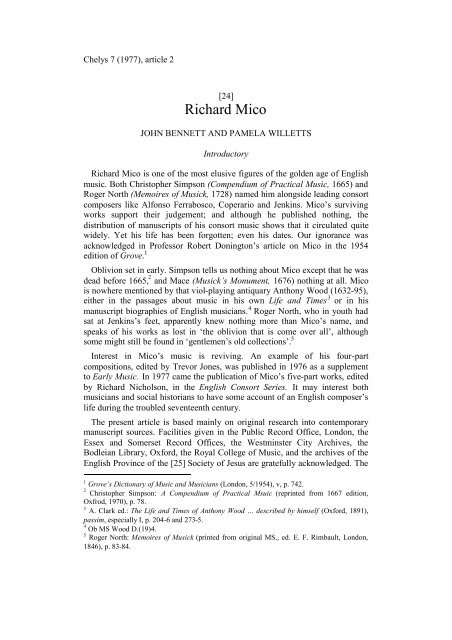download.pdf - 6.3Mb - Viola da Gamba Society
download.pdf - 6.3Mb - Viola da Gamba Society
download.pdf - 6.3Mb - Viola da Gamba Society
Create successful ePaper yourself
Turn your PDF publications into a flip-book with our unique Google optimized e-Paper software.
Chelys 7 (1977), article 2<br />
[24]<br />
Richard Mico<br />
JOHN BENNETT AND PAMELA WILLETTS<br />
Introductory<br />
Richard Mico is one of the most elusive figures of the golden age of English<br />
music. Both Christopher Simpson (Compendium of Practical Music, 1665) and<br />
Roger North (Memoires of Musick, 1728) named him alongside leading consort<br />
composers like Alfonso Ferrabosco, Coperario and Jenkins. Mico’s surviving<br />
works support their judgement; and although he published nothing, the<br />
distribution of manuscripts of his consort music shows that it circulated quite<br />
widely. Yet his life has been forgotten; even his <strong>da</strong>tes. Our ignorance was<br />
acknowledged in Professor Robert Donington’s article on Mico in the 1954<br />
edition of Grove. 1<br />
Oblivion set in early. Simpson tells us nothing about Mico except that he was<br />
dead before 1665, 2 and Mace (Musick’s Monument, 1676) nothing at all. Mico<br />
is nowhere mentioned by that viol-playing antiquary Anthony Wood (1632-95),<br />
either in the passages about music in his own Life and Times 3 or in his<br />
manuscript biographies of English musicians. 4 Roger North, who in youth had<br />
sat at Jenkins’s feet, apparently knew nothing more than Mico’s name, and<br />
speaks of his works as lost in ‘the oblivion that is come over all’, although<br />
some might still be found in ‘gentlemen’s old collections’. 5<br />
Interest in Mico’s music is reviving. An example of his four-part<br />
compositions, edited by Trevor Jones, was published in 1976 as a supplement<br />
to Early Music. In 1977 came the publication of Mico’s five-part works, edited<br />
by Richard Nicholson, in the English Consort Series. It may interest both<br />
musicians and social historians to have some account of an English composer’s<br />
life during the troubled seventeenth century.<br />
The present article is based mainly on original research into contemporary<br />
manuscript sources. Facilities given in the Public Record Office, London, the<br />
Essex and Somerset Record Offices, the Westminster City Archives, the<br />
Bodleian Library, Oxford, the Royal College of Music, and the archives of the<br />
English Province of the [25] <strong>Society</strong> of Jesus are gratefully acknowledged. The<br />
1 Grove’s Dictionary of Music and Musicians (London, 5/1954), v, p. 742.<br />
2 Christopher Simpson: A Compendium of Practical Msuic (reprinted from 1667 edition,<br />
Oxfrod, 1970), p. 78.<br />
3 A. Clark ed.: The Life and Times of Anthony Wood … described by himself (Oxford, 1891),<br />
passim, especially I, p. 204-6 and 273-5.<br />
4 Ob MS Wood D.(19)4.<br />
5 Roger North: Memoires of Musick (printed from original MS., ed. E. F. Rimbault, London,<br />
1846), p. 83-84.
















